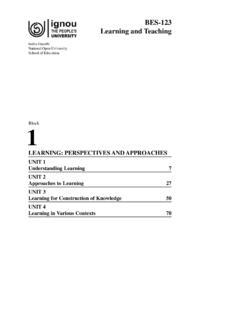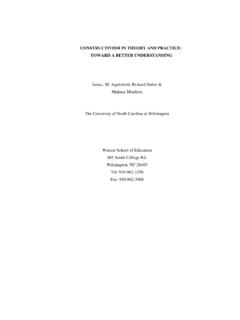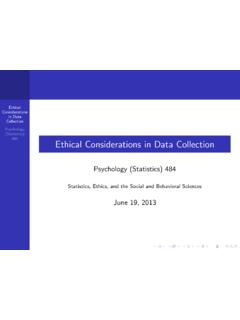Transcription of Values and benefits of heritage: A research review
1 Compiled by the heritage Lottery Fund Strategy and Business Development Department Gareth Maeer / Amelia Robinson / Marie Hobson April 2016 Values and benefits of heritage A research review _____ Values and benefits of heritage : a research review by HLF Strategy & Business Development Department. April 2016 2 Contents Values AND benefits OF heritage : A research review .. 3 1. VALUING heritage .. 5 People s perception of heritage value .. 5 Museums and Galleries .. 5 The Historic Environment .. 5 The Natural Environment .. 5 Monetising the value of heritage .. 6 Willingness to Pay .. 6 Property Prices .. 7 Time and donations as proxy measures of 8 Monetary Donations .. 8 Volunteering .. 8 2. VISITING heritage .. 9 Visiting Patterns .. 9 Museums and Galleries .. 9 The Historic Environment ..10 The Natural Environment ..11 Motivation for visits ..12 Museums and Galleries ..12 The Historic Environment.
2 12 The Natural Environment ..13 Barriers to Visiting ..13 3. SOCIAL benefits OF heritage FOR INDIVIDUALS ..14 Museums and Galleries ..14 The Historic Environment ..15 The Natural Environment ..16 4. SOCIAL benefits OF heritage FOR COMMUNITIES ..18 Museums and Galleries ..18 The Historic Environment ..19 The Natural Environment ..19 5. ECONOMIC benefits OF heritage ..20 National / regional studies ..20 Single attraction studies ..24 Museums and Galleries ..24 The Historic Environment ..24 Values and benefits of heritage : a research review by HLF Strategy & Business Development Department. April 2016 3 The Natural Environment ..24 Cross Sector ..25 Places for business ..26 Economic security ..28 REFERENCES ..29 Values and benefits of heritage : a research review by HLF Strategy & Business Development Department. April 2016 4 Introduction A research review of the Values and benefits of heritage has been published by the HLF s Strategy and Business Development department annually since 2007.
3 The review sets out the key information from a range of reports which are relevant to the heritage sector. Each year, the report is updated to include new research that has been published during the course of the year. This research review covers reports that were published before the end of 2015. The topics covered are: 1. Valuing heritage looks at people s perception of the value of heritage and ways of quantifying that value 2. Visiting heritage includes numbers, motivations and barriers to visiting heritage sites 3. Social benefits of heritage for individuals explores the relationship between visiting heritage sites and health and wellbeing 4. Social benefits of heritage for communities examines the role heritage can play in creating a sense of place and fostering a sense of community cohesion 5. Economic benefits of heritage . The areas of heritage covered are: Museums and galleries including museums, art galleries, libraries and archives Historic environment including the built environment, heritage sites, railways, visitor centres and places of worship Natural environment including parks, gardens, wildlife attractions, coasts, canals and green space As in previous years, we have only included research that features quantitative results, or larger-scale, in-depth qualitative studies.
4 When reviewing evaluation studies that assess the impact of funded projects and programmes, we have only included studies that carried out primary research with final beneficiaries ( visitors, participants, volunteers etc.), and have excluded research that only involves contact with project managers. We have only included evidence from the UK. We have excluded conceptual explorations of value and impact, discussions of impact methodologies or frameworks and research that is small-scale and/or anecdotal. Values and benefits of heritage : a research review by HLF Strategy & Business Development Department. April 2016 5 1. Valuing heritage People s perception of heritage value Museums and Galleries People value museums and galleries. A MORI (2004) survey of 4,000 British adults for the Museums Libraries and Archives council (MLA) found that 82% of people think it is important for their local town or city to have its own museum or art gallery1.
5 According to a Britain Thinks (2013) study into people s perceptions of and attitudes towards the roles and purposes of museums in society, both visitors and non-visitors have a strong, positive emotional attachment to museums and a sophisticated understanding of how museums shape our future as well as our past2. The Historic Environment heritage sites and buildings are seen as important to local communities. A Cebr (2013) survey of 2,001 UK adults found that 69%, equating to approximately 35 million people, felt that local heritage buildings and sites are important to their local community3. This is particularly felt amongst older people with almost three-quarters (73%) of over 55s agreeing with this sentiment in comparison to 64% of 18-34 year olds. heritage sites and buildings play an important part in how people view the places they live, how they feel and their quality of life. A report by IPSOS MORI (2010), into perceptions of beauty, shows the built environment plays an important role in how people view the places they live4.
6 A striking area of consensus in the findings was the value people placed on old versus new buildings. Across all age groups, older buildings were favoured as being more beautiful than newer ones. The most common reason people gave was that older buildings conveyed a sense of longevity and grandeur. This was also found in research conducted by IPSOS-RSL (2003) for the BBC s Restoration series in which 64% of respondents claimed they preferred old buildings over new ones5. People are interested in how the built environment looks. A MORI (2001) survey of 1,300 people in London for English heritage found 81% of people said they are interested in how the built environment looks and feels, with about a third (34%) saying they are very interested 6. Only 2% were not at all interested . Likewise, research conducted by IPSOS-RSL (2003), in preparation for the BBC s Restoration series, found that: 66% of respondents feel depressed by empty, derelict buildings; 63% said we do not do enough in the UK to look after historic buildings; and three quarters were concerned about the current loss of historic buildings7.
7 The Natural Environment People want to live near green spaces, such as parks and commons. A DEFRA-commissioned survey (Thornton, 2009) of English adults attitudes towards the environment found that 74% of participants thought that having green spaces, such as Values and benefits of heritage : a research review by HLF Strategy & Business Development Department. April 2016 6 parks, gardens and commons, nearby was very important and 21% thought it was fairly important 8. Similarly, a Natural England (2015) survey found that 44% agreed and 49% strongly agreed with the statement having green spaces close to where I live is important 9. In addition, when asked what makes somewhere a good place to live, respondents to the Scottish Social Attitudes Survey, selected green amenities ( open spaces, trees and greenery) ahead of transport, jobs, housing and local services10. Monetising the value of heritage Willingness to Pay Going beyond these basic kinds of survey results, environmental economists have attempted to monetise the extent to which people value heritage , by using willingness to pay (WTP) or stated preference studies, so that costs can be compared to benefits in the same unit of measurement.
8 This is a survey-based technique that aims to understand the value people place on resources that are not directly sold in a market. These studies show that: Non-users are willing to pay to maintain heritage facilities, even though they do not use them. In 2014, English heritage carried out a new stated preference study for two of its sites, Walmer Castle and Gardens in Kent, and Castle Acre Priory in Norfolk11. Both visitors and local people were asked what they would be willing to pay to maintain the site and keep it open. The study found that people value the preservation of heritage buildings and places even when receiving no direct benefit (use value ) from it (Eftec, 2014, p56). A willingness to pay study focused on the Surrey History Centre in Woking found that users were WTP 35 per year to prevent closure of the Centre, with even non-users prepared to pay an average of 13 per year12. What people are willing to pay is often more than the cost of the service.
9 For example, a Spectrum Consulting (2004) survey of 2,000 people in the UK found an annual WTP for the British Library of 363m, against a public subsidy of 83m13. In addition, a similar but more localised study was undertaken by Jura Consultants for MLA North West and Bolton Metropolitan Borough Council (2005)14. This showed that users and non-users valued Bolton s museum, library and archive service at an annual , against a cost of the service of There has been much more extensive work of this kind in the area of nature conservation and landscape than either the built environment or museums. Useful meta-reviews include: The UK National Ecosystem Assessment (UK NEA) provides a comprehensive overview of valuation studies dealing with both natural and cultural A research project between EH, HLF, DCMS and the Department of Transport by consultants eftec found 29 valuation studies that are directly applicable to historical sites, built heritage and archaeological sites, world-wide (eftec, 2005).
10 16 A comprehensive review carried out for the Department for Environment, Food and Rural Affairs (Defra) by eftec was published in An earlier eftec / Entec report Values and benefits of heritage : a research review by HLF Strategy & Business Development Department. April 2016 7 reviewed studies that have used environmental economics to value the external benefits of undeveloped Property Prices Property prices are another way to gauge people s WTP for heritage if we find that house prices are higher close to certain types of heritage (all other things being equal) then this represents a dividend that people are willing to pay to live in the vicinity of that heritage . The UK s National Ecosystem Assessment (2011) analysed 1 million housing transactions in England between 1996 and 2008 to conclude that there is substantial value attached to a number of natural habitats, designations, heritage sites, private gardens and local environmental amenities (p1100)19.







